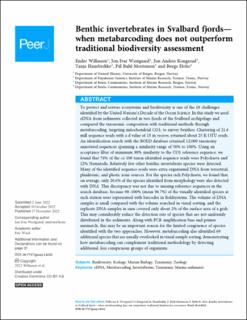| dc.description.abstract | To protect and restore ecosystems and biodiversity is one of the 10 challenges identified by the United Nations’s Decade of the Ocean Science. In this study we used eDNA from sediments collected in two fjords of the Svalbard archipelago and compared the taxonomic composition with traditional methods through metabarcoding, targeting mitochondrial CO1, to survey benthos. Clustering of 21.6 mill sequence reads with a d value of 13 in swarm, returned about 25 K OTU reads. An identification search with the BOLD database returned 12,000 taxonomy annotated sequences spanning a similarity range of 50% to 100%. Using an acceptance filter of minimum 90% similarity to the CO1 reference sequence, we found that 74% of the ca 100 taxon identified sequence reads were Polychaeta and 22% Nematoda. Relatively few other benthic invertebrate species were detected. Many of the identified sequence reads were extra-organismal DNA from terrestrial, planktonic, and photic zone sources. For the species rich Polychaeta, we found that, on average, only 20.6% of the species identified from morphology were also detected with DNA. This discrepancy was not due to missing reference sequences in the search database, because 90–100% (mean 96.7%) of the visually identified species at each station were represented with barcodes in Boldsystems. The volume of DNA samples is small compared with the volume searched in visual sorting, and the replicate DNA-samples in sum covered only about 2% of the surface area of a grab. This may considerably reduce the detection rate of species that are not uniformly distributed in the sediments. Along with PCR amplification bias and primer mismatch, this may be an important reason for the limited congruence of species identified with the two approaches. However, metabarcoding also identified 69 additional species that are usually overlooked in visual sample sorting, demonstrating how metabarcoding can complement traditional methodology by detecting additional, less conspicuous groups of organisms. | en_US |

